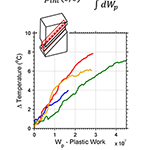As the microstructure of a material is refined from the micron scale to the nanoscale there is a significant increase in interface density. If the interface density is high enough, the macroscopic deformation response can be controlled by the structure of the interface at the nanoscale. Shown below is a comparison of two interface types, cube-on-cube and incoherent twin. In the cube-on-cube interface structure the deformation systems are aligned across the interface as is indicated by the identical orientations of the Thomson tetrahedron on both sides of the bi-metallic interface. Alternatively, the incoherent interface has a single aligned deformation plane as indicated. The mechanical response is shown for materials that consist predominantly of cube-on-cube and incoherent twin orientation illustrating the difference in macroscopic material response that can be elicited based on nanoscale interface structure.
Deformation Twinning:
Because of the low symmetry hexagonal close packed atomic structure of Mg there are a limited number of deformation mechanisms to accommodate deformation along the crystallographic c-axis. Only one dislocation slip based mechanism can accommodate deformation along the c-axis. Therefore, deformation twinning plays a dominant role in the accommodation of deformation along the c-axis. To date there have been a number of studies to examine twinning but there are still a number of critical details that need to be addressed to properly inform modeling efforts. Current, on going work looks to understand the kinematics of twinning through high strain rate experiments coupled with ultra-high speed photography.
High speed digital image correlation is combined with high strain rate loading to probe the evolution of strain localization leading up to failure in Mg alloys. From this study pathways for deformation are identified which lead to undesired shear band formation and crack formation. Show below is a comparison of the strain localization that occurs at a machined defect for three different loading orientations. The principle crystal orientation is provided for each loading orientation demonstrating the important role that texture can play in deformation processes.

Using infra-red thermography and selected orientations, high strain rate loading is used to evaluate the conversion of plastic work to heat for specific deformation processes in magnesium alloy AZ31B. Mechanisms are approached through studying orientations that accommodate deformation through primary classifications. Shown below is a schematic of an infra-red thermography set up, representative raw data trace from which stress, strain and temperature rise can be extracted, and a demonstration of the temperature rises observed for a loading orientation in which plasticity is dominated by basal slip.
 Using infra-red thermography and selected orientations, high strain rate loading is used to evaluate the conversion of plastic work to heat for specific deformation processes in magnesium alloy AZ31B. Mechanisms are approached through studying orientations that accommodate deformation through primary classifications. Shown below is a schematic of an infra-red thermography set up, representative raw data trace from which stress, strain and temperature rise can be extracted, and a demonstration of the temperature rises observed for a loading orientation in which plasticity is dominated by basal slip.
Using infra-red thermography and selected orientations, high strain rate loading is used to evaluate the conversion of plastic work to heat for specific deformation processes in magnesium alloy AZ31B. Mechanisms are approached through studying orientations that accommodate deformation through primary classifications. Shown below is a schematic of an infra-red thermography set up, representative raw data trace from which stress, strain and temperature rise can be extracted, and a demonstration of the temperature rises observed for a loading orientation in which plasticity is dominated by basal slip. 
